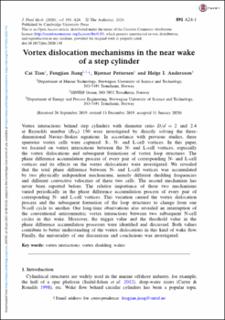| dc.contributor.author | Tian, Cai | |
| dc.contributor.author | Jiang, Fengjian | |
| dc.contributor.author | Pettersen, Bjørnar | |
| dc.contributor.author | Andersson, Helge Ingolf | |
| dc.date.accessioned | 2021-02-12T09:06:05Z | |
| dc.date.available | 2021-02-12T09:06:05Z | |
| dc.date.created | 2020-03-27T16:19:25Z | |
| dc.date.issued | 2020 | |
| dc.identifier.citation | Journal of Fluid Mechanics. 2020, 891 A24-1-A24-31. | en_US |
| dc.identifier.issn | 0022-1120 | |
| dc.identifier.uri | https://hdl.handle.net/11250/2727609 | |
| dc.description.abstract | Vortex interactions behind step cylinders with diameter ratio D/d = 2 and 2.4 at Reynolds number ( ReD ) 150 were investigated by directly solving the three-dimensional Navier–Stokes equations. In accordance with previous studies, three spanwise vortex cells were captured: S-, N- and L-cell vortices. In this paper, we focused on vortex interactions between the N- and L-cell vortices, especially the vortex dislocations and subsequent formations of vortex loop structures. The phase difference accumulation process of every pair of corresponding N- and L-cell vortices and its effects on the vortex dislocations were investigated. We revealed that the total phase difference between N- and L-cell vortices was accumulated by two physically independent mechanisms, namely different shedding frequencies and different convective velocities of these two cells. The second mechanism has never been reported before. The relative importance of these two mechanisms varied periodically in the phase difference accumulation process of every pair of corresponding N- and L-cell vortices. This variation caused the vortex dislocation process and the subsequent formation of the loop structures to change from one N-cell cycle to another. Our long-time observations also revealed an interruption of the conventional antisymmetric vortex interactions between two subsequent N-cell cycles in this wake. Moreover, the trigger value and the threshold value in the phase difference accumulation processes were identified and discussed. Both values contribute to better understanding of the vortex dislocations in this kind of wake flow. Finally, the universality of our discussions and conclusions was investigated. | en_US |
| dc.language.iso | eng | en_US |
| dc.publisher | Cambridge University Press | en_US |
| dc.relation.uri | https://www.cambridge.org/core/services/aop-cambridge-core/content/view/DD080C04CC8B6B76562A2116C1CDF4D0/S002211202000110Xa.pdf/vortex_dislocation_mechanisms_in_the_near_wake_of_a_step_cylinder.pdf | |
| dc.rights | Navngivelse 4.0 Internasjonal | * |
| dc.rights.uri | http://creativecommons.org/licenses/by/4.0/deed.no | * |
| dc.title | Vortex dislocation mechanisms in the near wake of a step cylinder | en_US |
| dc.type | Peer reviewed | en_US |
| dc.type | Journal article | en_US |
| dc.description.version | publishedVersion | en_US |
| dc.source.pagenumber | A24-1-A24-31 | en_US |
| dc.source.volume | 891 | en_US |
| dc.source.journal | Journal of Fluid Mechanics | en_US |
| dc.identifier.doi | 10.1017/jfm.2020.110 | |
| dc.identifier.cristin | 1804006 | |
| dc.relation.project | Notur/NorStore: nn9191k | en_US |
| dc.description.localcode | © The Author(s), 2020. Published by Cambridge University Press. This is an Open Access article, distributed under the terms of the Creative Commons Attribution licence (http://creativecommons.org/licenses/by/4.0/), which permits unrestricted re-use, distribution, and reproduction in any medium, provided the original work is properly cited | en_US |
| cristin.ispublished | true | |
| cristin.fulltext | original | |
| cristin.qualitycode | 2 | |

